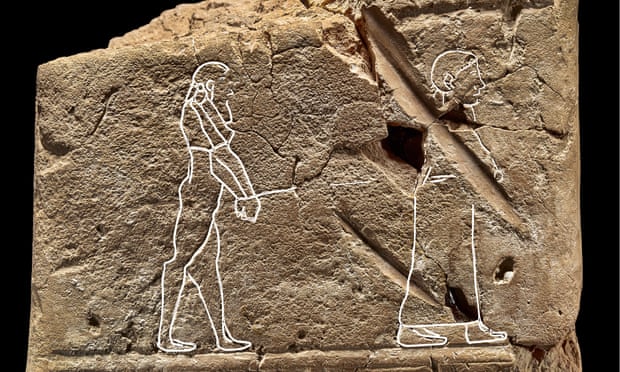Do not look behind you —
The Babylonian tablet may have come from an ancient exorcist’s library.
Kiona N. Smith
–

Photograph: The British Museum
A curator exploring the shadowy recesses of the British Museum’s archives recently encountered a ghost—or rather, the world’s oldest image of one, etched onto a 3,500-year-old Babylonian clay tablet. The figure of a tall, emaciated spirit with his hands bound illustrates the text of an ancient exorcism ritual meant to banish the sort of ghost that “seizes hold of a person and pursues him and cannot be loosed.”
Irving Finkel, the curator of the British Museum’s Middle Eastern department and a specialist in cuneiform, the angular writing system of the ancient Babylonian civilization, recently translated the text of the ritual, which had remained unread and ignored since the British Museum acquired the tablet in the 1800s. At that time, museums across Europe were in a rush to stockpile Babylonian artifacts, and curators would often pay local people to loot clay and stone tablets, along with other artifacts, from archaeological sites in what is now Iraq. Most of those items arrived with little or no information about their context and ended up in storage.
Seeing ghosts
The ghost tablet, for example, had never been displayed to the public, and no one had translated its text. Nor had anyone noticed the hidden ghostly image on the reverse side of the clay tablet, either. That side appears blank until it’s viewed under a light at just the right angle, when the image of the ghost seems to leap out at the viewer.
In the illustration, a woman in a long dress is leading the bound ghost into the afterlife. The ritual described on the opposite side of the tablet was meant to banish a ghost by assuaging the loneliness that kept it tied to the world of the living.
“You can imagine a tall, thin, bearded ghost hanging about the house did get on people’s nerves,” Finkel told The Guardian’s Dalya Alberge. “The final analysis was that what this ghost needed was a lover.”
Finkel hopes to put the tablet on display in the future. He says the exorcism ritual—and its ideas about the kinds of unfinished business that might keep a spirit from resting—reveals how little human nature has really changed in the last 3,000 years. It also sheds some light on an often-overlooked ancient civilization.
“I want people to know about this culture. Egypt always wins in Hollywood,” he told Alberge. “If the Babylonian underworld is anything like it was described, then they’re all still there. So just remember that.”
Try this at home
Here’s a summary of the tablet, just in case you need to banish a lonely hearted ghost this Halloween.
First, prepare two figurines: one to represent the ghost and one to represent the partner you’re offering it to. The lack of actual human sacrifice is convenient for a home project, but the text assumes you’re dealing with a male ghost who would like a female partner. For less heteronormative hauntings, adjust accordingly.
“You dress the man in an everyday shift and equip him with travel provisions. You wrap the woman in four red garments and clothe her in a purple cloth. You give her a golden brooch. You equip her fully with bed, chair, mat, and towel; you give her a comb and a flask,” according to the text.
Once you have your figurines ready, it’s time to set everything up for the ritual. “At sunrise, toward the Sun, make the ritual arrangements and set up two carnelian vessels of beer. You set in place a special vessel and set up a juniper censer with juniper. You draw the curtain like that of the diviner,” advises the tablet. “You [put] the figurines together with their equipment and place them in position.”
Now it’s time to invoke the Babylonian god of the Sun, who also moonlighted as judge of the underworld. “Say as follows: Shamash.”
The final piece of advice is perhaps the most important: “Do not look behind you.”

